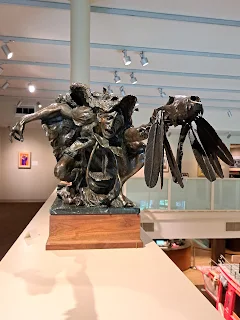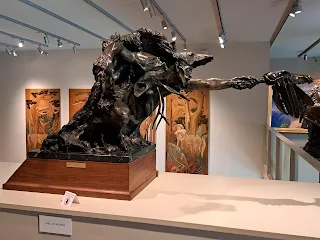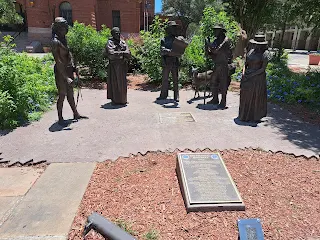HNS 2023 was busy with sessions from dawn to dusk. I was so absorbed with greeting old writing friends and meeting new ones that I only took these pictures on June 10th (the day of the book festival) and 11th (actually my birthday, the day after the conference, when I visited the Briscoe Western Art Museum before flying home). I did get to take a riverboat cruise and go on an HNS tour of the Alamo, too, but I was too busy listening to the tour and then chatting with my fellow authors to bother with pictures. I still have close to 80 hours of recorded classes (so many going on at once) to listen to in the next couple of months, sometime, somehow! BTW, I've always considered Savannah about as hot as it gets, but nope--San Antonio was scorchin'! Also... the museum confirmed that Texas is the West, not the South :). They had a whole display of 'What does the West mean for you?'
Silk: Caroline's Story;Tapestry: A Lowcountry Rapunzel; and Homespun.
My Blog:
Monday, June 26, 2023
Historical Novel Society Conference 2023 in San Antonio
Thursday, June 22, 2023
Author Interview with Kayleigh R. Thiel
Author Kayleigh R. Thiel
My smile vanished. It was replaced by a sudden pain, like a stapler trying to close the hole where my heart once lived.
-from Gifts of Stolen Embers by Kayleigh R. Thiel
I met Kayleigh R. Thiel at a writing conference in Atlanta just over a month ago, along with dozens of other authors. Her new-mom glow was sweet, and she showed me her debut novel right along with pictures of her baby. I soon went on my way, but her comment that she'd spent ten years on the book--as long as it took me to get Silk out--stayed with me, making me curious enough to download a sample. I was hooked from page one, stunned that Kayleigh's sweet demeanor hid such poetic brilliance--and breathtaking violence!
A master of the metaphor, Kayleigh keeps the intensity at a ten for much of this thriller. It’s about a headstrong perfectionist named Sarah who grows up to find herself endangered by human traffickers, but they soon find themselves the endangered ones! The novel jumps in time all over the place, back and forth from her young girlhood to her jaded, determined adulthood. Any other author would likely have lost me with the inconsistent, ongoing time jumps, but Thiel is a sublime storyteller, crafting words as an art form. I didn’t get particularly emotional about the characters, and the plotline was not what drew me in, either—it was her author voice!
Kayleigh was so kind as to meet with me and answer some questions:
1. What inspired you to write Gifts of Stolen Embers? Did it come to you (for the most part) all at once or in pieces?
I was obsessed with the idea of a badass heroine. I was raised on 1990s and early 2000s movies, so I loved watching women take charge and defeat their obstacles. So I knew I wanted to write a character like that. And I was always obsessed with the idea of vigilante justice. However, I completely rewrote this novel four times, so it definitely came to me in pieces.
2. What was your writing process for Gifts of Stolen Embers? How long did it take you to write the first rough draft? Was it initially written in a more linear fashion?
I began writing it when I was 18 years old on sheets of notebook paper. I focused on Sarah: how she would emerge a badass after her supposed best friend betrayed her and took her into the Colorado Mountains. It was garbage! I trashed the whole thing.
I restarted it and realized that Blaine was not the antagonist--he was a good man doing bad things to protect the person he loved; his motivation was always love for the family who'd taken him in.
At some point, though, I took a hiatus of a year or two. Life got in the way, and I started working on short stories and poetry. When I restarted my novel for a third time, I brought it to the global stage and made the correlations with themes from Frankenstein: love and isolation, justice and vengeance simmering beneath the surface. I leaned into that.
Then I read Story by Robert McKee, and it changed my writing process completely. I started from scratch again, and the fourth time I could actually see publishing it. I probably completed 50 revisions of the fourth manuscript.
I was never not writing my story. I became so immersed in Sarah that I saw everything and felt everything through her eyes. Daily life was an exercise in her characterization--I was simply a vessel for her spirit. I would be hiking in Colorado, and all of a sudden my brain would be like, "So Sarah would say this that way, not the way you have it written. And move it from page 35 paragraph 2 to page 37 paragraph 6."
I read The War of Art by Steven Pressfield, and he talks about this muse inside our brain that works while we are resting. It edits our work for us. And I truly believe that. When I read his book, it was like he was explaining what happens in my head. Actually, I was so immersed in Sarah's character that it took me six months to be able to write my new characters from an unbiased standpoint. Her voice was still very much alive in my head.
3. Tell me more about Sarah. What inspired you to create such a headstrong character? While I stayed on Sarah’s side, her risky choices and harsh treatment of Blaine made her less likeable. I wondered if we perhaps weren’t getting the full explanation of why she was still angry with him, of why she didn’t believe him about the trafficking ring despite the obvious proof of a shooter in her house. Can you tell us more about that?
Sarah came to me incredibly stubborn--she wouldn't try to be liked by the reader. Even as an activist, she acknowledges that she is not altruistic, that there are ulterior motives. She doesn't expect anything from anyone so that she'll never be disappointed. Over and over again, Blaine disappears or surprises her with his violence, and because of this, she warns herself that she can't trust him. Nevertheless, Blaine provides her an escape; no matter what she thinks and no matter what he does, she cannot help but love Blaine.
Though she sees the shooter in the house, to her this is not evidence of anything but the fact that Blaine has kept more secrets from her. "There are systems in place to handle these kinds of things," she always convinces herself.
Isolation due to her lack of trust in anyone but the system is her major character flaw. However, this all changes when she finally breaks away from society's civilized systems, unleashing the anger and frustration that has gripped her for so long. She wants to act despite all the rules and laws caging her, forging a life in complete opposition to the one she's been living. Instead of the observant angel, she becomes the avenging monster.
4. Which character do you identify with most in your story? How are you like Sarah? Are you more like Beth or other characters in ways?
Beth is most like me as a cheery, steadfast friend, and Sarah really needs an ordinary friend. However, like Sarah, I am shocked when our system fails. I'm like Blaine in vehemently protecting those I love.
5. What prompted you to make Sarah a budding alcoholic?
It stems from her mother's drinking problem, a way to cope with being so overwhelmed with schoolwork and activism that she essentially cares nothing about. She longs for an escape--even though society says it is a good life.
6. A pervading theme of frustration regarding institutions wasting Sarah’s valuable volunteer time contributes to her taking matters more directly into her own hands. Many of us can relate to that frustration with red tape and wheels spinning—or nonsense such as baking cupcakes to support diabetics (in my experience, they were having a barbeque to support heart disease patients). Did any particular personal experiences inspire this frustrated train of thought about charities and volunteerism? Did you work out more direct ways that you, personally, could more effectively take action towards your favored activist movements?
I started volunteering when I was 13. I worked at the Joint Township District Memorial Hospital in St. Mary's, Ohio bringing food to patients. Later, I volunteered for an equestrian therapy farm helping kids with muscular dystrophy.
One instance that did not inspire, but was definitely on my mind when I wrote Jael, was when I volunteered for the Big Brother Big Sister program. I only went to one meeting. I can't remember if it was in Ohio or Colorado, but I remember being assigned to a little boy who would have been around Jael's age. He described in vivid detail how his father had committed suicide, and I panicked. I couldn't go back because (at the time) I thought, "Who am I to help this kid? I am a fraud. He'll see through me. I have no answers and no way to help him, and he will know it."
I didn't realize that activism is the change. The journey is the destination. (Beth knows this.)
7. Which moral lessons were you trying to convey with this story?
The world works in moral greys and give-and-takes. Yes, we can succumb to the darkness, but lose our hearts in the shadows. Yes, we can make our own way so long as we are comfortable being on our own. Yes, we can fight monsters, but be careful because we might become one.
8. I met you at a writing conference in Atlanta, a city notorious for human trafficking, but the novel is set in Colorado. I was mystified by this until I saw that you went to college there. Did you grow up in Colorado? Did you write the novel there?
My writing has definitely changed over time. I've always kept a writing journal, but now I also have an excel spreadsheet with 40+ scene cards written in the way that Lisa Cron revealed in Story Genius. I also have a word doc for superfluous notes, and completely separate virtual folders for all my characters. I also have a timeline document. I have to keep everything organized because something can and will interrupt me at all times, and I need to immerse myself in my scenes as quickly as possible when I return to it. I write in snippets, keeping detailed notes on everything.
My husband has always been supportive of my writing, but now he is like my author co-worker! We plan when he watches the baby so that I can take an hour or two to write. We've scheduled 3 designated hours on Saturdays: 0900-1200.
I was never one of those writers to wait for inspiration. I am disciplined. I try to write something at least five times a week.
I'm a different reader since the baby, too. I can't read anything about children in danger (irony, I know).
10. At what age did you start writing? Does it come easily for you?
I do not remember a time that I was not reading or writing something. My parents can't remember either! I was always making up stories. And I think as I get older, it's easier for me to think of a collective storyline, but when I was younger, it was a lot harder to be organized.
11. Where did you learn the writing craft?
My grandparents, mom, and aunts and uncles are all huge readers; from a young age I was surrounded by stacks of paperbacks overflowing desks and bookshelves and even closets. I learned a lot through reading so much so young.
My degree is in English, and I've continued to read books on writing. Lisa Cron's Story Genius, Robert McKee's Story, and Donald Maas's Writing the Break Out Novel were so valuable that they changed the way I thought about drafting and editing.
12. Your metaphors are continuously spectacular. Are you also a poet?
Thank you! I have dabbled in poetry. I won a "War From My View" poetry competition at the Pikes Peak Community College in Colorado Springs. I also love reading poetry: Alfred Lord Tennyson, Rupi Kaur, and Sylvia Plath are my absolute favorites. However, I would never say I was a poet. I sincerely revere those who can make me feel so much emotion with a single line, and I try to mimic that power in my writing.
13. Did you win any other awards for your writing?
Yes, when I was in elementary school, I won the Dare Essay contest (haha). I grew up in a very small town in Ohio called New Bremen, and I was the only junior high student from there to make it to the state championship in a writing competition called The Power of the Pen. I also published a few pieces on the Rearrange literary website for PPCC. One of my short stories won a contest to be published in the Collage Journal at Middle Tennessee State University.
14. Do you have more novels planned? Are any manuscripts completed? Do you plan to stay in the same genre?
Similar to how Gifts of Stolen Embers was loosely influenced by Frankenstein, my next novel is loosely inspired by the Greek myth of Persephone. It's got hauntings, mythology, long-lost best friends, an eerie mansion, and a missing artist. I've finished the first rough draft, and I have about twenty more revisions to go.
15. Who are some of your favorite authors? Who were your childhood favorite authors?
Childhood favorites: Madeleine L'Engle, J.K. Rowling, Caroline B. Cooney, Meg Cabot (Princess Diary Series), and I was obsessed with Carolyn Keene's Nancy Drew series.
Present favorites: Simone St. James, Nathaniel Hawthorne, Edgar Allen Poe, Anthony Doerr, Lianne Moriarty, V.E. Schwab, Marisha Pessl, Taylor Jenkins Reid, and I loved Hide by Kiersten White (though I haven't read anything else by her).
Tuesday, June 20, 2023
Regional Writing Award from NIEA for Tapestry!
Tapestry: A Lowcountry Rapunzel is following in the footsteps of Silk: Caroline's Story in being named a finalist for the 17th annual National Indie Excellence Awards in the category of Regional: Southeast! Yay!
https://www.indieexcellence.com/17th-annual-finalists-tbd
Friday, June 2, 2023
Author Interview with the Historical Novel Society for Homespun
Hear about how a fortune-teller influenced my writing career and more in this HNS interview with me by Leslie S. Lowe.

















